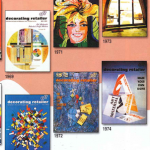In September of 1964, a small St. Louis-based organization known as the Paint and Wallpaper Association of America launched a monthly trade magazine entitled Decorating Retailer. Much like the association itself, the magazine was established as a “means of giving paint and wallpaper retailers organizational clout in the industry.”
Half a century and more than 500 issues later, that magazine – and the industry it covers – has experienced a long and winding narrative featuring equal parts struggle, survival and success.
it covers – has experienced a long and winding narrative featuring equal parts struggle, survival and success.
It all began at a time when a little-known British rock band called The Beatles made its television debut on the Ed Sullivan Show and Barack Obama was just a toddler. There were about 56 million homes in the U.S., with an average household income of about $6,500. The average price for a gallon of paint was about $4.
In the design world of the late 1960s, bold colors and busy designs were the norm, while vinyl wall covering and latex paint were still relatively new to the scene. In 1971, in order to reflect the ever-increasing product lines and the narrowing niches, the PWAA changed its name to the National Decorating Products Association.
By the time Johnson was in office and the Vietnam War had broken out, the big bold styles of the previous decade had been replaced by more muted earth tones – especially browns. Window treatments including drapes, shades and blinds also grew in popularity around this time.
Despite a strained economy during the early-80s recession, people were actually spending more on home decoration than ever before, making it one of the few industries to thrive at this time. By the mid-80s, the media – namely television – had a firm grip on the country’s collective conscious and people were spending more and more of their leisure time within their four walls. So why not enjoy the space?
With the economic troubles a worry of the past, home decorating became more sophisticated and more refined than ever before, influenced by both European style and faux finishes including sponging, ragging, wood graining and marbleizing. This meant more products, more tools and more sales. It was also around this time that independent retailers began to shift their focus from individual customers to contractors and commercial/industrial clients. From the perspective of an indie retailer, things couldn’t be better.
Enter the 90s, and a few of the biggest challenges to ever hit the industry came all at once. The increased focus on environmentalism, which meant stricter regulations for production and disposal of paint materials, combined with the double-edged sword of advanced technology to offer as many problems as it did solutions. Times were changing, and the demands of the industry were shifting faster than some retailers could keep up with.
Add to that the explosion of the big box stores, especially the Home Depot. With their prime locations, extensive inventories and seemingly limitless budgets, indie retailers were suddenly at a disadvantage in a billion-dollar industry they had helped define.
By 1996, the association had changed its name again, this time to the Paint & Decorating Retailers Association. The magazine also got a new name, becoming what you know today as Paint & Decorating Retailer. It had become clear that paint was the bread and butter for many retailers, and the organization responded accordingly.
By the turn of the century, corporate buyouts and consolidation in the industry had become commonplace. Big box stores were growing in number and impact – as were online retailers – and the home decorating game became a battle of survival of the fittest. For the independents that would ultimately survive, that meant a keener focus on customer service and unique product lines. And while the number of indie retailers was by then in decline, those still in business were beginning to use technology to their advantage and reap its benefits.
Then, in the late 2000s, another recession hit. Hard. Like most other industries, home decorating suffered, some stores forced to close their doors for the final time. As many retailers discovered, preparation and planning could be the difference between making it and not.
Which brings us to today. In a world of competition, online marketplaces, ever-advancing technologies and ever-increasing product lines, it can be hard for indie retailers to keep up. Transition, it seems, is the only constant of the industry, and it requires you to adapt and innovate.
But, as always, you don’t have to go it alone.
As Paint & Decorating Retailer celebrates its golden anniversary, it renews its commitment and dedication to providing the advice, the support and the resources to help you succeed. We’ve been with you through style changes, environmental and technological transitions, the emergence of big box retailers, and several recessions to boot. It has been a challenging, but extremely rewarding, 50 years.
Here’s to 50 more.






